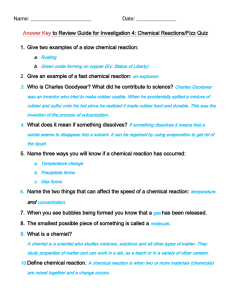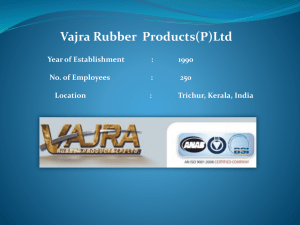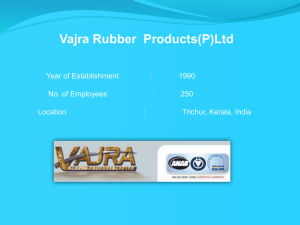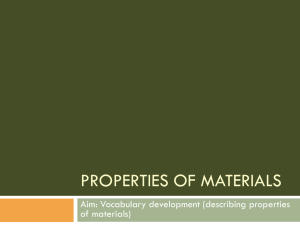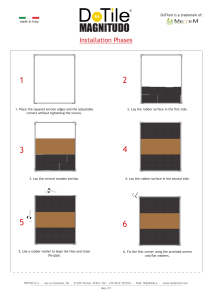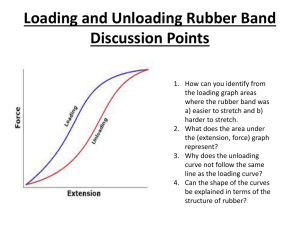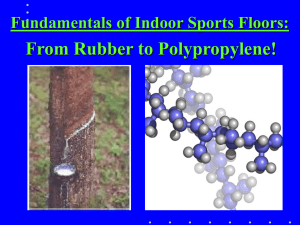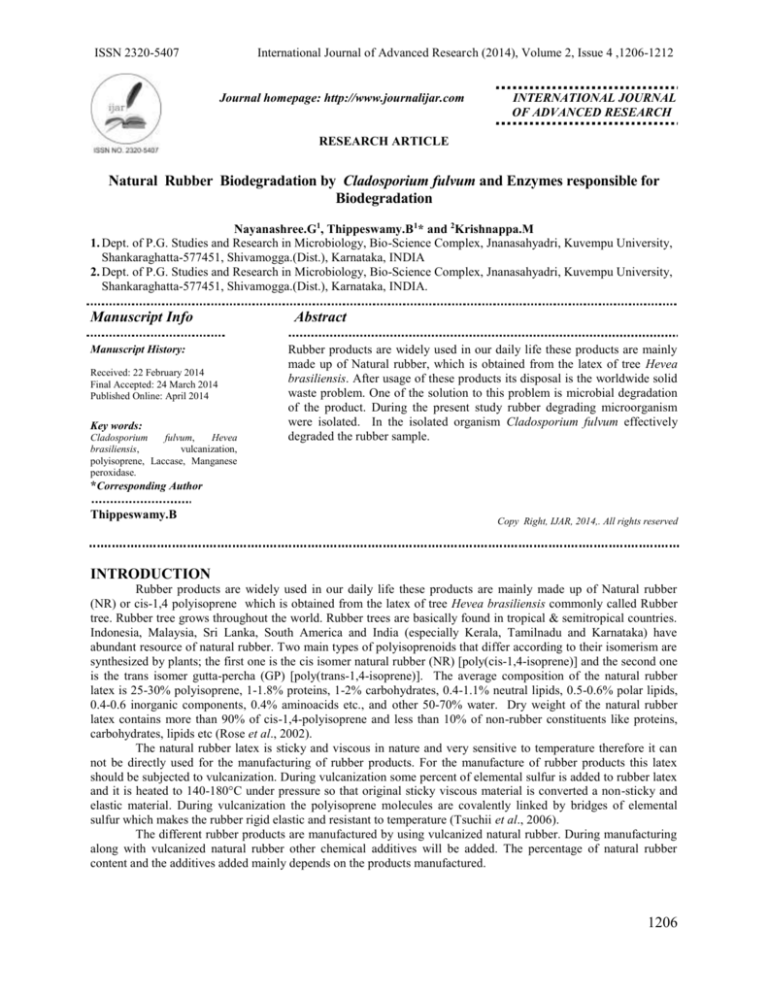
ISSN 2320-5407
International Journal of Advanced Research (2014), Volume 2, Issue 4 ,1206-1212
Journal homepage: http://www.journalijar.com
INTERNATIONAL JOURNAL
OF ADVANCED RESEARCH
RESEARCH ARTICLE
Natural Rubber Biodegradation by Cladosporium fulvum and Enzymes responsible for
Biodegradation
Nayanashree.G1, Thippeswamy.B1* and 2Krishnappa.M
1. Dept. of P.G. Studies and Research in Microbiology, Bio-Science Complex, Jnanasahyadri, Kuvempu University,
Shankaraghatta-577451, Shivamogga.(Dist.), Karnataka, INDIA
2. Dept. of P.G. Studies and Research in Microbiology, Bio-Science Complex, Jnanasahyadri, Kuvempu University,
Shankaraghatta-577451, Shivamogga.(Dist.), Karnataka, INDIA.
.
Manuscript Info
Manuscript History:
Received: 22 February 2014
Final Accepted: 24 March 2014
Published Online: April 2014
Key words:
Cladosporium
fulvum,
Hevea
brasiliensis,
vulcanization,
polyisoprene, Laccase, Manganese
peroxidase.
Abstract
Rubber products are widely used in our daily life these products are mainly
made up of Natural rubber, which is obtained from the latex of tree Hevea
brasiliensis. After usage of these products its disposal is the worldwide solid
waste problem. One of the solution to this problem is microbial degradation
of the product. During the present study rubber degrading microorganism
were isolated. In the isolated organism Cladosporium fulvum effectively
degraded the rubber sample.
*Corresponding Author
Thippeswamy.B
Copy Right, IJAR, 2014,. All rights reserved
INTRODUCTION
Rubber products are widely used in our daily life these products are mainly made up of Natural rubber
(NR) or cis-1,4 polyisoprene which is obtained from the latex of tree Hevea brasiliensis commonly called Rubber
tree. Rubber tree grows throughout the world. Rubber trees are basically found in tropical & semitropical countries.
Indonesia, Malaysia, Sri Lanka, South America and India (especially Kerala, Tamilnadu and Karnataka) have
abundant resource of natural rubber. Two main types of polyisoprenoids that differ according to their isomerism are
synthesized by plants; the first one is the cis isomer natural rubber (NR) [poly(cis-1,4-isoprene)] and the second one
is the trans isomer gutta-percha (GP) [poly(trans-1,4-isoprene)]. The average composition of the natural rubber
latex is 25-30% polyisoprene, 1-1.8% proteins, 1-2% carbohydrates, 0.4-1.1% neutral lipids, 0.5-0.6% polar lipids,
0.4-0.6 inorganic components, 0.4% aminoacids etc., and other 50-70% water. Dry weight of the natural rubber
latex contains more than 90% of cis-1,4-polyisoprene and less than 10% of non-rubber constituents like proteins,
carbohydrates, lipids etc (Rose et al., 2002).
The natural rubber latex is sticky and viscous in nature and very sensitive to temperature therefore it can
not be directly used for the manufacturing of rubber products. For the manufacture of rubber products this latex
should be subjected to vulcanization. During vulcanization some percent of elemental sulfur is added to rubber latex
and it is heated to 140-180°C under pressure so that original sticky viscous material is converted a non-sticky and
elastic material. During vulcanization the polyisoprene molecules are covalently linked by bridges of elemental
sulfur which makes the rubber rigid elastic and resistant to temperature (Tsuchii et al., 2006).
The different rubber products are manufactured by using vulcanized natural rubber. During manufacturing
along with vulcanized natural rubber other chemical additives will be added. The percentage of natural rubber
content and the additives added mainly depends on the products manufactured.
1206
ISSN 2320-5407
International Journal of Advanced Research (2014), Volume 2, Issue 4 ,1206-1212
The global rubber consumption is estimated to be 12.5 million metric tons in 2013 of which 65% were used
for tire production and other 35% is used for the production of other rubber products such as rubber balloons, mats,
rubber bands, pipes, gaskets, sheets etc.
After usage of these natural rubber products the disposal of these products are the world wide solid waste
problem. One of the solution to reduce this problem is to recycle the used waste rubber. But due to the chemical
cross linking formed during vulcanization it is not possible to simply melt and reshape the products as in case of
polythene. So other alternatives such as microbial degradation of the product should be developed. Microbial
degradation is mainly carried out by various microorganisms such as bacteria and fungi (Lions et al., 2000).
The present study was taken to isolate the natural rubber degrading fungi from the soil so that it can be used
to degrade the rubber waste and to study the enzymes responsible for degradation
MATERIALS AND METHODS
For the isolation of fungi which were able to degrade natural rubber, the soil sample was collected from a
local land fill of Shivamogga district and brought to the laboratory, along with this natural rubber latex and natural
rubber sheet samples were collected from rubber processing unit and then it was brought to the laboratory and
preserved in the refrigerator for further use.
Isolation of natural rubber degrading fungi
For the isolation of natural rubber degrading fungi soil burial method was followed. Natural rubber small
discs were weighed and initial weight was recorded. Then, these discs were dumped in the soil and left for a period
of six months of time interval. These natural rubber discs were removed regularly at time interval of two, four and
six months respectively and weighed. For the isolation of natural rubber degrading fungi soil sample and natural
rubber samples were plated on the potato dextrose agar media and kept for incubation at room temperature at
272ºC for 3 to 4 days for the isolation of fungi (Tsuchi et al., 1996). After incubation period, fungi were identified
by staining and based on their microscopic and macroscopic appearance using standard manuals (Ellis, 1971 and
1976; Pitt, 1979; Domsch et al., 1980 ;Subramanian, 1983; Ellis, 1997; Gilman, 2001; Nagamani et al., 2006).
Plate assay for the screening of fungi capable of degrading natural rubber
For the screening of natural rubber degrading fungi pure culture isolates were directly inoculated on the
sterilized, pre weighed natural rubber discs and then kept for incubation for 2 months. After a time interval of 2
months natural rubber sample inoculated with organisms were washed thoroughly, dried at 50°C in hot air oven for
24 hours and final weight was recorded (Borel et al.,1981).
Screening of natural rubber degradation by using Mineral salt medium (MSM)
Natural rubber degrading ability of the fungi was checked in the laboratory conditions by growth
experiment in mineral salt medium (MSM) (Pan et al., 2009), where natural rubber was used as sole carbon source.
Previously isolated fungi were inoculated to different conical flasks containing MSM and kept for incubation for 2
months on rotary shaker. Fungi were incubated at 27±2°C, triplicates were maintained. After incubation period
natural rubber discs were removed and observed for the growth of fungi. Then natural rubber discs were washed
dried at 50°C in hot air oven for 24 hours and weight loss was checked (Tsuchii and Tokiwa, 2001).
Confirmation of natural rubber degradation by staining with Schiff’s reagent
Evidence for degradation and mineralization of cis-1,4-polyisoprene rubber hydrocarbon chain was
obtained by staining treated natural rubber discs with Schiff’s reagent. In a tightly stopper bottle, 10 ml of fuchsin
reagent was added to a sample and kept for incubation for 10-30 minutes at room temperature. After 10-30 minutes
excess amount of the reagent was discarded and 10ml of the sulfite solution was added in order to suppress
nonspecific reaction of untreated sample (Berekka et al., 2000).
Confirmation of natural rubber degradation by Scanning Electron Microscopy (SEM)
Evidence for degradation and mineralization of cis-1, 4-polyisoprene natural rubber hydrocarbon chain was
obtained by observing the natural rubber discs under SEM. For the observation natural rubber discs buried in the
soil and present in the MSM, which were subjected for degradation were observed under field emission-scanning
electron microscopy (FEI-SIRION, Eindhoven, Netherland) (Lions et al., 2000).
Confirmation of natural rubber degradation by Fourier Transform Infrared Spectroscopy (FTIR)
1207
ISSN 2320-5407
International Journal of Advanced Research (2014), Volume 2, Issue 4 ,1206-1212
Chemical changes that arose directly on the natural rubber surface as result of the degradation process were
determined using FTIR spectroscopy. NICOLET 380 FTIR spectrophotometer from Thermo Fisher Scientific,
France was used which gives transmittance spectra in IR range 4000 to 400 nm. (Roy et al., 2005).
Characterization of enzymes responsible for biodegradation of natural rubber
It was studied that laccase and manganese peroxidase enzymes were responsible for the natural rubber
degradation.
Screening for Laccase and Manganese peroxidase enzyme production by Cladosporium fulvum
Screening for laccase enzyme produced by Cladosporium fulvum was done on plates containing following
composition (g/l): 3.0 peptone, 10.0 glucose, 0.6 KH 2PO4, 0.001 ZnSO4, 0.4 K2HPO4, 0.0005 FeSO4, 0.05 MnSO4,
0.5 MgSO4, 20.0 Agar (pH-6) supplemented with 0.02% guaiacol. Cladosporium fulvum was inoculated into this
plate and the plate was incubated at 30°C for 7 days. Laccase activity was visualized on plates containing 0.02%
guaiacol, since laccase catalyzes the oxidative polymerization of guaiacol to form reddish brown zones in the
medium (Viswanath et al., 2008).
For the screening of manganese peroxidase enzyme producing organisms H 2O2 was added to the laccase
screening media.
Mass production of enzyme by submerged fermentation
Pure cultures of Cladosporium fulvum was inoculated to submerged state fermentation medium for the
production of extracellular enzymes by using MSM media and was maintained at the incubation temperature of
27±2ºC for 3 months (Shraddha et al., 2011).
Determination of Laccase and Manganese peroxidase enzyme activity by using Spectrophotometer
Guaiacol (2mM) in sodium acetate buffer (10mM pH 5.0) was used as substrate. The reaction mixture
contained 3ml 10mM acetate buffer of pH 5, 1ml guaiacol and 1ml enzyme source and enzyme blank contained 1ml
of distilled water instead of enzyme source. The mixture was incubated at 30ºC for 15minutes and absorbance was
read at 450nm blank using UV spectrophotometer (Papinutti et al., 2006). Manganese peroxidase enzyme activity
was calculated by following laccase enzyme activity determination procedure, but for the reaction mixture 1 ml of
H2O2 was added and incubated.
Protein estimation
Protein concentration was estimated to determine specific activity of enzyme. The protein concentration
was determined by the Lowry’s method, as described by Lowry’s (1951) using Bovine Serum Albumin (BSA) as a
standard, absorbance was read at 660 nm using JENWAY- 6305 UV-VIS Spectrophotometer.
Testing of Natural Rubber degrading ability of enzymes
Degrading ability of the enzyme which were purified was tested by adding enzymes to the flasks containing
acetate buffer and previously weighed natural rubber sheets and kept for incubation on rotary shaker for a period of
15 days at room temperature. After incubation period rubber discs were weighed to check weight loss and subjected
for staining to confirm natural rubber degradation (Fujisawa et al., 2001).
RESULTS
Isolation of natural rubber degrading fungi
Rubber samples and the soil sample of 2, 4 and 6 months were plated on the potato dextrose agar medium,
different 14 fungi were isolated and recorded. In the isolated organism Cladosporium fulvum was pre-dominant and
commonly isolated. Thus it was screened to test natural rubber degrading ability. Weight loss was also observed in
all the rubber samples which was removed at different time interval (Table 1).
Table -1. Weight loss of rubber by soil burial method
Result are expressed in standard error where n=3.
Sl.No.
Number
months
1.
2.
3.
of
2
Initial weight (
g)
3
Final Weight
( g)
2.84
Weight loss
(g )
0.16±0.01
Weight loss In
( %)
5.3
4
3
2.63
0.37±0.04
12.3
6
3
2.12
0.88±0.01
29.3
1208
ISSN 2320-5407
International Journal of Advanced Research (2014), Volume 2, Issue 4 ,1206-1212
Plate assay for the screening of microorganisms capable of degrading natural rubber
In Cladosporium fulvum inoculated natural rubber discs initial weight was 10g and final weight was 8.46g
and there was a decrease in 1.54 ± 0.001g of weight and percentage of weight loss was 15.4%.
Screening of natural rubber degradation by using Mineral salt medium (MSM)
Growth experiment was conducted by using mineral salt medium weight loss was observed and growth of
fungi was observed on the rubber discs. Initial weight of the Cladosporium fulvum inoculated rubber strip was 2g
and the final weight was 1.34g and there was a weight loss of 0.66±0.002g and percentage of weight loss was 33%.
Confirmation of rubber degradation by staining with schiff’s reagent
Rubber sheets which were inoculated with microorganism turned to purple colour and there was no colour
formation in the control. Formation of purple colour in the treated sample is due to the presence of aldehyde and
ketone group which is produced as a result of degradation of cis-1,4-polyisoprene units.
Confirmation of natural rubber degradation by Scanning Electron Microscopy (SEM)
Natural rubber discs were observed under SEM, bio-film formation, complete disintegration and formation
of cavities on the natural rubber discs was observed (Fig. 1).
Rubber discs buried in soil
Cladosporium fulvum treated
Control
Fig. 1. SEM images of natural rubber showing degradation
Confirmation of natural rubber degradation by Fourier Transform Infrared Spectroscopy (FTIR)
Natural rubber discs, which were treated by Cladosporium fulvum were subjected for FTIR studies peaks
were observed at the wave length between 2725.89 cm-1 and 1662.34 cm-1 having H–C=O:C–H stretch and C=O
stretch which indicates the presence of aldehydes and ketones, released as a result of natural rubber degradation in
the treated sample. Presence of these aldehyde and ketone group confirms natural rubber degradation. Peaks
showing the presence of aldehyde and ketone are absent in control (Fig. 2).
Rubber control
Cladosporium fulvum treated
Fig. 2. Confirmation of natural rubber degradation by FTIR
Enzymatic studies of rubber degradation
It was studied that laccase and manganese peroxidase enzymes were responsible for the rubber degradation.
Screening for Laccase and Manganese peroxidase enzyme production by Cladosporium fulvum
Cladosporium fulvum was inoculated on the laccase and manganese peroxidase medium there was a
formation of reddish brown colour around the colonies since laccase and manganese peroxidase catalyzes the
oxidative polymerization of guaiacol to form reddish brown zone. Cladosporium fulvum which showed positive
result for rubber degradation showed positive result for laccase and manganese peroxidase enzyme screening.
Determination of Laccase and Manganese peroxidase enzyme activity by using Spectrophotometer
1209
ISSN 2320-5407
International Journal of Advanced Research (2014), Volume 2, Issue 4 ,1206-1212
0.015
0.01
0.005
0
Laccase enzyme
1st week
2nd week
3rd week
4th week
5th week
6th week
7th week
8th week
9th week
10th week
11th week
12th week
Enzyme activity in I.U.
Cladosporium fulvum, showed more manganese peroxidase activity compared to laccase activity. Both
laccase and manganese peroxidase enzyme activity was maximum in 10 th week. Laccase enzyme activity in 10th
week was 0.0184 IU and manganese peroxidase activity in 10th week was 0.0197 IU.
Table 2. Showing laccase and manganese peroxidase activity
Cladospor 1st
2nd
3rd
4th
5th
6th
7th
8th
9th
10th
11th
12th
ium
wee wee
week
week week week Wee wee
wee
wee
week week
fulvum
k
k
k
k
k
k
Laccase
0
0
0.001 0.002 0.004 0.006 0.00 0.00 0.01 0.01 0.011 0.010
3
2
1
4
78
91
04
21
2
1
Mangenes
0
0
0.001 0.002 0.004 0.006 0.00 0.01 0.01 0.01 0.011 0.009
e
5
8
5
9
89
06
12
35
6
8
peroxidase
Manganese peroxidase
enzyme
Incubation time in week
Fig. 3. Laccase and Manganese peroxidase enzyme activity in IU
Testing of Rubber degrading ability of enzymes
After incubation time weight loss were observed in rubber pieces and formation of pink colour was also
observed when treated rubber pieces were subjected to schiffs staining.
After incubation time when weight was checked there was decrease in 0.4 g of weight in laccase enzyme
inoculated sample and 0.5g weight loss in manganese peroxidase inoculated sample.
DISCUSSION
Present study was carried out to isolate natural rubber degrading fungi. It was studied that Cladosporium
fulvum is capable of degrading natural rubber. Degradation of natural rubber was studied by carrying out growth
experiment in MSM, and degradation was confirmed by staining, SEM, FTIR studies. Further enzyme responsible
for degradation was studied. Laccase and manganese peroxidase were the enzymes responsible for degradation.
Similar attempts were made by several other scientists to degrade rubber by using microorganisms.
Roy et al.,(2005) made an attempt to study on natural rubber (NR) biodegradation through solid-state
fermentation (SSF) and submerged fermentation (SMF) has been carried out for both bacterial as well as fungal
species. There was a change in the organic carbon content along with the average molecular weight of the treated
rubber samples indicated rubber hydrocarbon utilization and its degradation.
Berekaa et al., (2000) conducted similar work and tested the biodegrading ability of different bacteria
belonging to the genera Gordonia (strains Kb2, Kd2 and VH2), Mycobacterium, Micromonospora and
Pseudomonas. All strains were able to use natural rubber (NR) as well as NR latex gloves as sole carbon source.
Similar study was carried out by Tokiwa et al., (1999) in his study he showed that forty-seven percent of
a tire tread strip with a natural rubber content of 100 phr (parts per hundred of rubber) was completely mineralized
by a mutant strain, Rc, of the rubber-degrading organism, Nocardia sp. Strain 835A.
CONCLUSION
Rubber products are widely used in our daily life. These products are made up of natural vulcanized rubber
and other chemical additives. Due to vulcanization of the natural rubber these rubber are very resistant to high
temperature and persist in environment for very long time. Rubber materials have been increasingly used now a
days in different area after usage its disposal is a very big solid waste problem. It can not be easily recycled due to
1210
ISSN 2320-5407
International Journal of Advanced Research (2014), Volume 2, Issue 4 ,1206-1212
the sulphur cross linking formed during vulcanization. If they are burnt they release enormous amount of carbon-dioxide and some other gases which cause environmental pollution and contribute to the global warming. Rubber
products such as balloon which are disposed in the natural environment are considered to be dangerous to wild
animals if they are consumed by animals.
So, one of the alternative way to solve these problems is to subject these product to biodegradation. During
the present study rubber discs were dumped in the soil were removed at regular interval of time and then plated on
the media to isolate the organism. In the isolated organism and effectively degraded the rubber sample. The present
study has showed that, it is possible to use Cladosporium fulvum to degrade natural rubber effectively. Along with
this, enzymes responsible for natural rubber degradation were also characterized.
REFERENCE
Berekaa, M.M., Lions, A., Reichelt, R., Keller, U. and Steinbuchel, A. (2000). Effect of pretreatment of rubber
material on its Biodegradability by various rubber degrading Bacteria, FEMS Microbiology Letters, 184: 199206.
Borel, M., Kergomard, A., and Renard, F. (1981). Degradation of Natural rubber by fungi imperfecti, Agricultural
Biology and Chemistry, 46: 877-881.
Domsch, K.H., Gams, W. and Anderson, T.H. (1980). Compendium of soil fungi. Vol 1. Academic Press Inc. New
York: 1-859.
Ellis, M.B.(1971). Dematiaceous hyphomycetes. Kew: Common wealth mycological
institute. England: 1-608.
Ellis, M.B. (1976). More Dematiaceous hyphomycetes. Kew:Common wealth mycological institute. England: 1507.
Ellis, M.B. and Ellis, J.P. (1997). Microfungi on Land plants: An Identification Handbook. Richmond Publishers,
London: Croom Helm: 868.
Gilman, J.C. (2001). A manual of soil fungi. 2 nd edition. Biotechnology Books. New Delhi: 1-392.
Lions, A., Rudolf Reichelt, R., Keller, U. and Steinbuchel, A . (2000). A Gram negative bacterium identified as
Pseudomonas aeruginosa, AL98, is a potent degrader of natural rubber and synthetic cis-1,4-polyisoprene,
FEMS Microbiology Letters, 182: 155-161.
Lowry, O.H., Rosebrough, N.J., Farr, A.L., and Randall, R.J., (1951). Protein measurement with the folin phenol
reagent, Journal of general Microbiology, 31:3017-3027.
Nagamani, A., Kunwar, I.K. and Manoharachary, C. (2006) Handbook of Soil Fungi. I. K. International Pvt. Ltd.
New Delhi. 1-477.
Pan, L., Gung, G.J., Yin, B. and Cheng, P.S. (2009). Contribution to deterioration of polymeric materials by slow
growing Bacteria Nocardia corynebacterioides, International Biodegradation and Biodeterioration, 63: 24-29.
Papinutti, L., and Martinez, J. M., (2006). Production and Characterization of Laccase and Manganese peroxidase
from the ligninolytic fungus Fomes sclerodermeus, Journal of technology and biotechnology, 81:1064-1070.
Pitt, J.I. (1979). The genus Penicillium and its teleomorphic states Eupencillium and
Press Inc, Ltd. London:1-634.
Talaromyces. Academic
Roy, V.R., Das, M., Banrjee, R. and Bhowmick, A. (2005). Comparative studies on rubber biodegradation through
Solid state and Submerged fermentation, Process Biochemistry, 42: 181-186.
Shraddha, Shekher, R., Sehgal, S., Kamtania, M., and Kumar, A., (2011). Laccase microbial source Production,
Purification, Potential biotechnological application, Enzyme Research, 1-11.
1211
ISSN 2320-5407
International Journal of Advanced Research (2014), Volume 2, Issue 4 ,1206-1212
Subramanian, C.V. (1983). Hyphomycetes, taxonomy and biology. London. New York: Academic Press: 410-461.
Viswanath, B., Chandra, M. S., Pallavi, H., Reddy, (2008). Screening and Assessment of Laccase Producing Fungi
isolated from different environmental samples, African Journal of Biotechnology, 7:1129-1133.
Tsuchii, A. and Tokiwa, Y. (1999). Colonization and disintegration of Tire Rubber by a
Nocardia, Journal of Bioscience and Bioengineering, 87: 542-544.
colonial Mutant of
Tsuchii, A. and Tokiwa, Y. (2001). Microbial degradation of Tire rubber particles, Biotechnology Letters, 23: 963969.
Tsuchii, A., Takeda, K., Suzuki, T. and Tokiwa, Y. (1996). Colonization and degradation of rubber pieces by
Nocardia species, Biodegradation Journal, 7: 41-48.
1212


